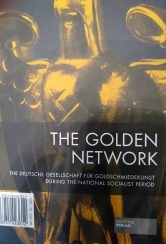Chapter extracts from:The Golden Network – The Deutsche Gesellschaft für Goldschmiedekunst During the National Socialist Period
© 2019 Societäts-Verlag, Frankfurt, authors, translator. ISBN: 978-3-95542-361-2 
When the Deutsche Gesellschaft für Goldschmiedekunst was founded at the initiative of court jeweler Ferdinand Richard Wilm at Berlin’s Altes Museum on August 3, 1932, the Weimar Republic was already in the final throes of its political agony. On account of the global economic and banking crisis, in combination with the Reich government’s deflation policy, Germany was grappling with severe economic depression, high mass unemployment, and the impoverishment and political radicalization of broad sections of the population. In many places, civil war-like circumstances prevailed on the streets. Electoral campaigns were characterized by violent clashes between paramilitary combat units of the NSDAP, KPD and SPD, during which hundreds of people were killed. Reich Chancellor von Papen, who had been appointed by Reich President Hindenburg, governed with his so-called “Cabinet of Barons” on the basis of emergency decrees, without the backing of parliament. On July 20, 1932, von Papen had deposed the social-democratically led Prussian government of Otto Braun by means of a “coup d’état”, thereby removing one of the last bastions against the increasingly radicalizing political movements. Finally, at the Reichstag elections of July 31, 1932, the NSDAP emerged as the strongest faction, with 37.4 percent of the votes, while the democratic parties lost their majority in parliament for the first time, which was to have far-reaching consequences for domestic political developments in Germany.
A few months previously, on April 10, 1932, the Altes Museum in Berlin had opened the temporary exhibition, “Der Schmuck als Kunstwerk” (“Jewelry as Artwork”), during which historical pieces of jewelry made out of precious metal from the Staatliche Museen zu Berlin (Berlin State Museums) were on show. The Berlin-based jeweler Ferdinand Richard Wilm was also among the museumgoers. Romanticizing somewhat, decades later his son Renatus Wilm wrote down that Ferdinand R. Wilm, while contemplating the exhibits, had come to realize that, although many people appreciated old works of art, only a few were willing to make any effort to train in art and perpetuate artistic heritage. On the very day of the exhibition opening, Ferdinand R. Wilm went to find the general director of the Staatliche Museen, Prof. Wilhelm Waetzoldt, in order to put to him his idea of founding a society for artistic goldsmithery. Waetzoldt reports on the encounter with Wilm in his memoirs: “Herr Wilm opened the conversation with his impressions of the exhibition and then went on to expound, with great warmth and clarity, the plan to found a society for artistic goldsmithery. For its setup he requested my assistance and the collaboration of the museum directors. So it began…”.
We may assume that April 1932 was not the date that Wilm first developed the aim of an independent German organization for goldsmiths. Rather, it is likely that he already had it in mind during his leadership of numerous committees of various associations and clubs. As head of the Freie Vereinigung des Gold- und Silberwarengewerbes Berlin (Free Association of the Gold and Silverware Industry Berlin), the Deutscher Kunstgewerbeverband (German Association of Arts and Crafts), or as chairman of the Reichsverband der Deutschen Juweliere (Reich Association of German Jewelers), Wilm had contact with artists as well as influential personalities from science and business. He was later able to make use of the contacts he made and the experience he garnered in this context when he founded the Gesellschaft für Goldschmiedekunst.
Click on the poppy for further extracts from The Golden Network![]()
